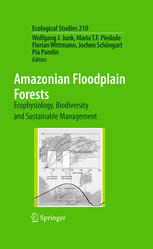

Most ebook files are in PDF format, so you can easily read them using various software such as Foxit Reader or directly on the Google Chrome browser.
Some ebook files are released by publishers in other formats such as .awz, .mobi, .epub, .fb2, etc. You may need to install specific software to read these formats on mobile/PC, such as Calibre.
Please read the tutorial at this link: https://ebookbell.com/faq
We offer FREE conversion to the popular formats you request; however, this may take some time. Therefore, right after payment, please email us, and we will try to provide the service as quickly as possible.
For some exceptional file formats or broken links (if any), please refrain from opening any disputes. Instead, email us first, and we will try to assist within a maximum of 6 hours.
EbookBell Team

4.4
82 reviewsCentral Amazonian floodplain forests are an unique and endangered ecosystem. The forests grow in areas that are annually flooded by large rivers during mean periods of up to 8 months and at depths of up to 10 m. Despite this severe stress, these forests consist of over 1,000 species and are by far the most species-rich floodplain forests worldwide. The trees show a broad range of morphological, anatomical, physiological, and phenological adaptations that enable them not only to survive the adverse environmental conditions, but also to produce large amounts of biomass when the nutrient levels in water and soils are sufficiently high. This is the case in the floodplains of white-water rivers, which are used for fisheries, agriculture, and cattle-ranching but which also have a high potential for the production of timber and non-timber products, when adequately managed. Latest research on ecophysiology gives insight how tree species adapt to the oscillating flood-pulse focusing on their photosynthesis, respiration, sap flow, biochemistry, phenology, wood and leave anatomy, root morphology and functioning, fruit chemistry, seed germination, seedling establishment, nitrogen fixation and genetic variability. Based on tree ages, lifetime growth rates and net primary production, new concepts are developed to improve the sustainability of traditional forest managements in the background of an integrated natural resource management. This is the first integrative book on the functioning and ecologically oriented use of floodplain forests in the tropics and sub-tropics.It provides fundamental knowledge for scientist, students, foresters and other professionals on their distribution, evolution and phytogeography. “This book is an excellent testimony to the interdisciplinary collaboration of a group of very dedicated scientists to unravel the functioning of the Amazonian Floodplain forests. They have brought together a highly valuable contribution on the distribution, ecology, primary production, ecophysiology, typology, biodiversity, and human use of these forests offering recommendations for sustainable management and future projects in science and development of these unique wetland ecosystems. It lays a solid scientific foundation for wetland ecologists, foresters, environmentalists, wetland managers, and all those interested in sustainable management in the tropics and subtropics.” Brij Gopal, Executive Vice President International Society for Limnology (SIL).